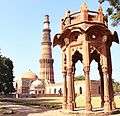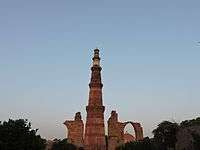Qutb Minar
Coordinates: 28°31′28″N 77°11′07″E / 28.524355°N 77.185248°E
| Qutb Minar قطب مینار कुतुब मिनार | |
|---|---|
|
Qutb Minar in Delhi, India | |
| Type | Cultural |
| Criteria | 7 |
| Designated | 1993 (17th session) |
| Reference no. | 233 |
| Country |
|
| Continent | Asia |
Qutb Minar,[1][2] (also spelled Qutub Minar) at 73 metres, is the tallest brick minaret in the world and second highest minar in India after Fateh Burj at Punjab, India. Qutb Minar, along with the ancient and medieval monuments surrounding it, form the Qutb complex, which is a UNESCO World Heritage Site.[2][3][3] The tower is located in the Mehrauli area of Delhi, India. The Minaret of Jam, a UNESCO World Heritage Site in western Afghanistan, is thought to have been a direct inspiration for the Qutb Minar in Delhi, which was also built by the Ghori (Mamluk) Dynasty. Made of red sandstone and marble, Qutb Minar is a 73-metres (240 feet) tall tapering tower with a diameter measuring 14.3 metres (47 feet) at the base and 2.7 metres (9 feet) at the peak.[4] Inside the tower, a circular staircase with 379 steps leads to the top.[5] Qutb Minar station is the closest station on the Delhi Metro.
In 1200 AD, Qutb al-Din Aibak, founder of the Delhi Sultanate, started construction of the Qutb Minar. In 1220, Aibak's successor and son-in-law Iltutmish added three storeys to the tower. In 1369, lightning struck the top storey, destroying it completely. So, Firoz Shah Tughlaq carried out restoration work replacing the damaged storey with two new storeys every year, made of red sandstone and white marble.[6][7]
Qutb Minar is surrounded by several historically significant monuments, which are historically connected with the tower and are part of the Qutb complex. These include the Iron Pillar of Delhi, Quwwat-ul-Islam Mosque, Alai Darwaza, the Tomb of Iltutmish, Alai Minar, Ala-ud-din's Madrasa and Tomb, and the Tomb of Imam Zamin. Other minor monuments include Major Smith's Cupola and Sanderson's Sundial.[2][3]
History


The construction of Qutb Minar was commissioned by Qutb al-Din Aibak, the founder of the Delhi Sultanate in 1192 AD.[8] The minar was built on the ruins of the Lal Kot, the Red Citadel in the city of Dhillika.[9] Aibak's successor Iltutmish added three more storeys to complete the tower.
It has not been established with certainty whether Qutb Minar has been named after Qutb al-Din Aibak, the emperor who commissioned its construction or Qutbuddin Bakhtiar Kaki, the famous Sufi saint.[10]
The culture of tower architecture was established in India before the arrival of the Turks. However, there is no evidence on record to confirm that the Qutb Minar was inspired or influenced by earlier Rajput towers.[11] Numerous inscriptions in Parso-Arabic and Nagari characters in different sections of the Qutb Minar reveal the history of its construction. According to the inscriptions on its surface it was repaired by Firoz Shah Tughlaq (1351–89) and Sikandar Lodi[12] (1489–1517).
The Quwwat-ul-Islam Mosque, located to the north of Qutb Minar, was built by Qutb al-Din Aibak in 1192. It is one of the earliest surviving mosque in the Indian subcontinent.[13][14] Later, an arched screen was erected and the mosque was enlarged by Iltutmish (1210–35) and Ala-ud-din Khilji.
The topmost storey was damaged by lightning in 1368 A.D. and was rebuilt by Firoz Shah Tughlaq. Firoz Shah Tughlaq built two floors one of which can be distinguished easily as it was built of white marble. In 1505, an earthquake damaged Qutb Minar and the damage was repaired by Sikander Lodi. On 1 September 1803, a major earthquake, possibly in Garhwal Kumaun Himalaya, again caused serious damage to Qutb Minar. Major Robert Smith of the British Indian Army renovated the tower in 1828 and installed a cupola to the top of Qutb Minar. The cupola was taken down in 1848, under instructions from The Viscount Hardinge, then Governor General of India and was installed to the east of Qutab Minar, where it rests now .[15]
Architecture
The Minar is made of bricks covered with intricate iron carvings and verses from the Qur'an. The Minar comprises several superposed flanged and cylindrical shafts, separated by balconies carrying Muqarnas corbels. The first three storeys are made of red sandstone; the fourth, fifth and sixth storeys are made of marble and sandstone. At the foot of the tower is the Quwwat ul Islam Mosque. The minar tilts just over 65 cm from the vertical, which is considered to be within safe limits, although experts have stated that monitoring is needed in case rainwater seepage further weakens the foundation.[7]

The nearby 7 meters high Iron Pillar from Gupta empire is a metallurgical curiosity. The pillar standing in the Qutb complex has Brahmic inscriptions on it and predates the Islamic minar.[3]
Accident
Before 1974, the general public was allowed access to the top of the minar accessed through a narrow staircase. On 4 December 1981, 45 people were killed in the stampede and there were 300 to 400 people inside the minar at that time that followed an electricity failure that plunged the tower's staircase into darkness. Most of the victims were children because at the time school children were allowed free access to historical monuments on Fridays. Subsequently, public access to the inside of the tower has been stopped.
In popular culture
Bollywood actor and director Dev Anand wanted to shoot the song "Dil Ka Bhanwar Kare Pukar" from his film Tere Ghar Ke Samne inside the Minar. However, the cameras in that era were too big to fit inside the tower's narrow passage, and therefor the song was shot inside a replica of the tower.[16] The site served as the pit stop of the second leg of the second series of The Amazing race Australia.
A picture of the minaret is featured on the travel cards issued by the Delhi Metro Rail Corporation. A recently launched start-up in collaboration with Archaeological survey of India has made a 360o walkthrough of Qutb Minar available.[17]
Gallery
 Smith's Cupola, Qutb Minar, Alai Darwaza and Tomb of Imam Zamin.
Smith's Cupola, Qutb Minar, Alai Darwaza and Tomb of Imam Zamin.- Qutb Minar
 QutbMinar Delhi
QutbMinar Delhi Decorative motifs on upper levels
Decorative motifs on upper levels Closer view of the balcony
Closer view of the balcony Closer view of the calligraphy.
Closer view of the calligraphy. Qutb Minar and Mehrauli Pillar together.
Qutb Minar and Mehrauli Pillar together. Alai Gate within Qutb Minar complex.
Alai Gate within Qutb Minar complex. The incomplete Alai Minar.
The incomplete Alai Minar.- Quwwat-ul-Islam Mosque.
 Calligraphic inscriptions inside the tomb of Iltutmish.
Calligraphic inscriptions inside the tomb of Iltutmish.
See also
References
- ↑ "World Heritage Sites - Qutb Minar". Archaeological Survey of India. Retrieved 1 August 2015.
- 1 2 3 "WHC list". whc.unesco.org. 2009. Retrieved 27 October 2011.
- 1 2 3 4 Singh (2010). Longman History & Civics ICSE 7. Pearson Education India. p. 42. ISBN 978-81-317-2887-1. Retrieved 27 October 2011.
- ↑ "Qutb Minar Height". qutubminardelhi.com. Archived from the original on 29 June 2015. Retrieved 15 June 2015.
- ↑ "Facts About Qutub Minar". Lifestyle Lounge: Travel. iloveindia.com. Retrieved 27 January 2013.
- ↑ "Qutub Minar". qutubminardelhi.com. Archived from the original on 22 June 2015. Retrieved 15 June 2015.
- 1 2 Verma, Richi (24 January 2009). "Qutb Minar tilting due to seepage: Experts". The Times of India. Retrieved 30 June 2012.
- ↑ Qutub Minar
- ↑ Ali Javid; ʻAlī Jāvīd; Tabassum Javeed (2008). World Heritage Monuments and Related Edifices in India. Google Books. pp. 14, 105, 107, 130. ISBN 9780875864822. Retrieved 26 May 2009.
- ↑ "Qutub Minar Height". qutubminardelhi.com. Archived from the original on 29 June 2015. Retrieved 15 June 2015.
- ↑ Chandra,Satish. Medieval India; From Sultanate to the Mughals Part One. p. 233
- ↑ File:Plaque at Qutub Minar.jpg
- ↑ "Quwwat-ul-Islam Mosque". qutubminardelhi.com. Archived from the original on 25 July 2015. Retrieved 15 June 2015.
- ↑ Ali Javid; ʻAlī Jāvīd; Tabassum Javeed (July 1, 2008). World Heritage Monuments and Related Edifices in India. Google Books. pp. 14, 105, 107, 130. Retrieved 26 May 2009.
- ↑ https://rangandatta.wordpress.com/2012/08/15/qutub-minar-and-smiths-folly-an-architectural-disaster/
- ↑ Mehul S Thakkar, Mumbai Mirror 22 Nov 2011, IST (22 November 2011). "30 years later, Qutub ready to face the camera — Times of India". Articles.timesofindia.indiatimes.com. Retrieved 26 September 2012.
- ↑ "Qutub Minar in MEHRAULI, Delhi - 360-degree view on WoNoBo.com". Places.wonobo.com. Retrieved 2014-05-17.
Further reading
- Ali Javid (July 1, 2008). World Heritage Monuments and Related Edifices in India (Full Set Bound in 2 Volumes). Algora Publishing. ISBN 978-0875864822.
External links
![]() Media related to Qutb Minar at Wikimedia Commons
Media related to Qutb Minar at Wikimedia Commons

